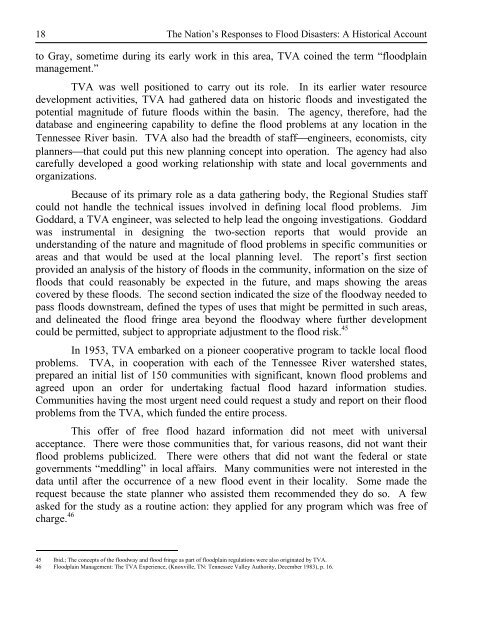The Nation's Responses To Flood Disasters: A Historical Account
The Nation's Responses To Flood Disasters: A Historical Account
The Nation's Responses To Flood Disasters: A Historical Account
Create successful ePaper yourself
Turn your PDF publications into a flip-book with our unique Google optimized e-Paper software.
18<br />
<strong>The</strong> Nation’s <strong>Responses</strong> to <strong>Flood</strong> <strong>Disasters</strong>: A <strong>Historical</strong> <strong>Account</strong><br />
to Gray, sometime during its early work in this area, TVA coined the term “floodplain<br />
management.”<br />
TVA was well positioned to carry out its role. In its earlier water resource<br />
development activities, TVA had gathered data on historic floods and investigated the<br />
potential magnitude of future floods within the basin. <strong>The</strong> agency, therefore, had the<br />
database and engineering capability to define the flood problems at any location in the<br />
Tennessee River basin. TVA also had the breadth of staff⎯engineers, economists, city<br />
planners⎯that could put this new planning concept into operation. <strong>The</strong> agency had also<br />
carefully developed a good working relationship with state and local governments and<br />
organizations.<br />
Because of its primary role as a data gathering body, the Regional Studies staff<br />
could not handle the technical issues involved in defining local flood problems. Jim<br />
Goddard, a TVA engineer, was selected to help lead the ongoing investigations. Goddard<br />
was instrumental in designing the two-section reports that would provide an<br />
understanding of the nature and magnitude of flood problems in specific communities or<br />
areas and that would be used at the local planning level. <strong>The</strong> report’s first section<br />
provided an analysis of the history of floods in the community, information on the size of<br />
floods that could reasonably be expected in the future, and maps showing the areas<br />
covered by these floods. <strong>The</strong> second section indicated the size of the floodway needed to<br />
pass floods downstream, defined the types of uses that might be permitted in such areas,<br />
and delineated the flood fringe area beyond the floodway where further development<br />
could be permitted, subject to appropriate adjustment to the flood risk. 45<br />
In 1953, TVA embarked on a pioneer cooperative program to tackle local flood<br />
problems. TVA, in cooperation with each of the Tennessee River watershed states,<br />
prepared an initial list of 150 communities with significant, known flood problems and<br />
agreed upon an order for undertaking factual flood hazard information studies.<br />
Communities having the most urgent need could request a study and report on their flood<br />
problems from the TVA, which funded the entire process.<br />
This offer of free flood hazard information did not meet with universal<br />
acceptance. <strong>The</strong>re were those communities that, for various reasons, did not want their<br />
flood problems publicized. <strong>The</strong>re were others that did not want the federal or state<br />
governments “meddling” in local affairs. Many communities were not interested in the<br />
data until after the occurrence of a new flood event in their locality. Some made the<br />
request because the state planner who assisted them recommended they do so. A few<br />
asked for the study as a routine action: they applied for any program which was free of<br />
charge. 46<br />
45 Ibid.; <strong>The</strong> concepts of the floodway and flood fringe as part of floodplain regulations were also originated by TVA.<br />
46 <strong>Flood</strong>plain Management: <strong>The</strong> TVA Experience, (Knoxville, TN: Tennessee Valley Authority, December 1983), p. 16.
















